
Europe and Mediterranean: Ephesus, Grecian Gems & Dalmation Coast Voyage
Seabourn®
Embark on an unparalleled journey through the cradle of civilization - the Mediterranean. From the moment you step on board your Seabourn luxury cruise ship, you will enter a world of history, culture, opulence, and exploration. Enjoy the sophistication of fine-dining restaurants, or the casual charm of al fresco eateries. Wake up to breathtaking views of azure waters and historic coastlines and immerse yourself in the rich tapestry of Mediterranean culture with expertly curated shore excursions to ancient landmarks and charming villages.

All onboard gratuities
Select complimentary shore excursions**
Unlimited beverages, including fine wines and premium spirits served throughout the ship
Complimentary dining venues
Complimentary in-suite bar
Complimentary caviar
Complimentary Wi-Fi packages with unlimited minutes
Welcome bottle of Champagne
Executive Member Benefit
Executive Members receive an annual 2% Reward, up to $1,250, on qualified Costco Travel purchases
Digital Costco Shop Card
Member Exclusive: Digital Costco Shop Card with every Seabourn® sailing†
Sailing Itinerary

Note: Cruise itineraries are subject to change. Please verify ports and times directly with the cruise line.
Overview
Dubrovnik - the city of a unique political and cultural history (the Dubrovnik Republic, the Statute from 1272), of world-famous cultural heritage and beauty (inscribed on the List of World Heritage Sites by Unesco) - is one of the most attractive and famous cities of the Mediterranean. Apart from its outstanding natural beauties and well-preserved cultural and historical heritage, Dubrovnik also offers high-quality visitor opportunities. It is also the city of hotels, high ecological standards, and tourist programs, and is equally attractive in all seasons. Its geographical isolation is compensated by high traffic and communication standards - especially through air traffic and fast hydrofoil boats. The tourist development of Dubrovnik started before the First World War; quite soon, the exclusiveness of its attractions made Dubrovnik a powerful international tourist center. The sightseeing of Dubrovnik and its monuments requires several days. However, already a walk through Stradun, through narrow streets and small squares, monumental ramparts and fortresses, provides enough opportunities to experience the millennial beauty of its shell-shaped urban core, centuries of building, stone-cutting, carving and engraving, the history of the Duke's Palace, libraries, the oldest pharmacy in the south of Europe, etc. Dubrovnik offers individual choice among numerous museums and galleries, which contain the jewels of Croatian heritage. The Dubrovnik Museum in the Duke's Palace keeps 15,500 exhibits in its cultural and historical department. A collection of furniture from the 17th-19th century, uniforms of dukes and councilors, aristocratic garments, and many other items are exhibited in the authentic halls of the palace. The Maritime Museum (situated in the fortress Sveti Ivan) has several exhibits on permanent display, related to the maritime affairs of Dubrovnik and Croatia on the whole, with a particular emphasis on the history of the Dubrovnik Republic. The museum of the Franciscan monastery keeps all inventories of the old pharmacy, as well as the works of Dubrovnik jewelers, painters, and embroiders. The Museum of the Dominican Monastery exhibits valuable examples of Dubrovnik paintings from the 15th and 16th centuries, as well as sculptures, jewelry, manuscripts, incunabula, and notes (music). The treasury of the Dubrovnik cathedral keeps the relics of St. Blaise, patron of Dubrovnik, and numerous paintings and works of art. The Rupe Ethnographical Museum presents traditional occupations and the rural architecture of the region of Dubrovnik, national costumes, and hand-made textiles. Very attractive is also the Aquarium of the Institute of Biology, situated in the fortress Sveti Ivan, comprising interesting marine species. Dubrovnik has several churches, monasteries, and hotels scattered all over the town. Its coastal belt is adorned with several marinas, piers, and promenades. Because of the magnificent view of the medieval Dubrovnik, a walk along the town ramparts is a must for each visitor. A great number of Dubrovnik restaurants and taverns offer delicious specialties of local and international cuisine. Sports and recreational facilities include playgrounds, courts, and requisites for all sports in the sea and on the ground, from tennis and table tennis to sailing and yachting. There are also several gyms and fitness centers with swimming pools, saunas, massage, aerobics, solarium, box gyms, etc. Dubrovnik is famous for quality hotels. Most of them are situated on the Lapad peninsula and in the area of Ploce, southeast of the old town. The hotel complex Dubrava - --Babin Kuk on Lapad has all the features of a small town. It has a shopping center, a bank, an outpatient department, many restaurants and cafés, and a street called the "New Stradun", which connects all hotels. Dubrovnik is the city of an outstanding cultural and artistic life. The most important event in the cultural life of the city is the Dubrovnik Summer Festival (10th of July - 25th of August), traditionally held since 1950. It is a theatre and classical and folk music festival since 1956 included in the calendar of world festivals and as such one of the most famous cultural events in the world. Concerts and other performances take place on open stages in the town (Gunduliceva Poljana, Drziceva Poljana, Lovrijenac, Revelin)or in beautiful interiors of the most famous buildings (Duke's Palace, cloisters, and churches). The repertoire includes works of Croatian and world classics, performed by the leading personalities from Croatia and abroad, including several world-famous actors, directors, conductors, etc. So far several hundred of them have performed in Dubrovnik. An important part of the Festival is his performances of local (Lindo, Lado) and foreign folk music ensembles. The artistic life of Dubrovnik is characterized by numerous exhibitions taking place throughout the year. Apart from already renowned galleries - the Art Gallery (Put Frana Supila 23), its exhibition space Luza Art Centre (Stradun), Sebastian - occasional and permanent exhibitions are also held in other spaces as well. Very famous are also Dubrovnik carnival festivities - so-called Dubrovnik "karnevo" (local variant of the word "carnival"), held ever since the early Middle Ages, when they were brought from neighboring Italy. Another important event is the Feast Day of St. Blaise, also the Day of Dubrovnik (3rd of February). The feast takes place for the whole week, including religious ceremonies, a procession through the town, concerts, sports events, entertainment, and carnival programs. Excursions to Dubrovnik during that week are regularly organized.
Overview
Kotor is a fortified town on Montenegro’s Adriatic coast, in a bay near the limestone cliffs of Mt. Lovcen. Characterized by winding streets and squares, its medieval old town has several Romanesque churches, including Kotor Cathedral. It's also home to the Maritime Museum, which explores local seafaring history. Sveti Ðorde, one of 2 tiny islands off the ancient town of Perast, features a centuries-old church.
Overview
Corfu Town (Kerkyra) is a principal port and the largest town in the Ionian islands. It is built between two Venetian castles, having its unique atmosphere. It is a thriving mass of shops and businesses, set amongst a captivating and charming assortment of elegant buildings, churches, imposing fortresses, and narrow alleyways leading to hidden squares. The tall buildings with the 'volta' (arches), the 'cantina' (narrow flagstoned streets), and the 'meralgia' (sea walls) are showing all a clear Italian influence. One of the most beautiful walks in the town is around the Esplanade (Spianada square), one of the biggest squares in Europe which is the hub of the Corfiot's life. Here you can walk around or sit in one of the many cafe bars underneath the arches of the 'Liston', a name probably derived from a similar promenade in Venice. Liston was built during the imperial French occupation and is reminiscent of the larger 'Arcades' of the Rue de Rivoli in Paris. On the upper side of the Esplanade stands a memorial to the British Lord High Commissioner Sir Thomas Maitland, built in 1816 in the shape of a circular building with Ionian columns. The Corfiots called this building 'sterna' (cistern) because this was where the entrance to the largest underground cistern of the town was to be found. Near the Maitland's monument, in front of the building where the Ionian Academy was housed, stands the statue of John Capodistrias, the first President of Greece. It is a work from the end of the 19th century showing the Governor standing deep in thought. Opposite the Liston is the Old Fortress and 'Anthonas', the Municipal Gardens. In the gardens is the statue of Lord Guilford, showing the founder of the Ionian Academy in his academic robes holding an open book. Nearby are the busts of two famous Corfiots, the poet Lorenzo Mavilis and the writer Dinos Theotokis. At the northern end of the Esplanade stands the Palace of St. Michael and St. George, one of the most elegant buildings in Corfu. Opposite the west front of the palace is a beautiful building that now houses the Reading Society of Corfu, the oldest cultural institute in modern Greece, founded in 1836. The Reading Society contains a unique library of Greek and foreign books as well as a large collection of manuscripts, newspapers, periodicals, paintings, maps and engravings mostly related to the Ionian islands. As one's gaze leaves the Esplanade, after lingering on the palace, it embraces a magnificent view towards the coastal road (Arseniou Street) with its sea walls Following along this road will take you to the Old Harbour of Corfu and the other Venetian castle, the one called the New Fortress. Along this road, the narrow lanes ('cantounia') lead to the Campielo, the oldest quarter of the town. Here the visitor can find the oldest houses and many of the historic churches in Corfu. At the northern end of Capodistria Street stands the Capodistria Mansion, an excellent example of neo-classical architecture. It was built in 1835 by the Corfiot architect John Chronis and is considered one of the most beautiful buildings in Greece. Here John Capodistrias, the first President of Greece, was born. Another notable landmark in the old town is the central market. The most interesting street here is Nickiforou Theotoki as the rows upon rows of 'volta' standing on their stone columns and the tall buildings form one of the most characteristic aspects of Corfu Town. In a little square on Nickiforou Theotoki Street stands the building of the Ionian Bank, which was built in 1846 displaying a well-proportioned facade with finely detailed Ionian pilasters and pediment. On the first floor of the building,g the Paper Money Museum is housed. At the far end of the square is the Church of St. Spyridon. It shelters the body of St. Spyridon, the patron saint of Corfu and one of the great Saints of Greek Orthodoxy, and draws a constant stream of pilgrims from all over Greece every year. On the Evgeniou Voulgareos Street stands the crenellated belfry of the Roman Catholic Church of the Annunciation a venerable building from the end of the 14th century. The whole building was destroyed in the World War II bombing, and the only remains are the belfry, two inscriptions, and a bas-relief representing war trophies. Between Evgeniou Voulgareos Street and a modern square stands the most elegant of the Venetian buildings in Corfu, the Town Hall in baroque style. At the end of Moustoxydi Street stands another building of the period of British rule, the historic Ionian Parliament. At the junction of the Garitsa coastal road and Alexandras Avenue stands the Douglas Obelisk, which also belongs to the same period, erected in honor of the Lord High Commissioner Sir Howard Douglas, to whom Corfu owes a lot of public works and philanthropic institutions.
Overview
The City of Split marks 1700 years since the beginning of the construction of Diocletian's Palace. Split, a city where every epoche since antiquity has left its traces, was conceived within the walls of the palace which was built by the Roman Emperor Diocletian as his private residence. The well-preserved palace has been listed as UNESCO's register of the world's cultural heritage. During these 1700 years, Split has played an important role in Croatian history. Today, Split is the center of cultural and scientific life, with many institutions, museums, galleries, and theatres. Split is the second biggest city in Croatia. Due to its central position on the Adriatic coast and its exceptional environment, Split soon developed into the leading and biggest city of South Croatia, its large port, commercial and industrial center, and an important European tourist resort. The present city of Split is an organic fusion of its antique heritage and modern architecture, set up in a beautiful Mediterranean environment and full of the sober and thoughtful atmosphere of a big city. As the scientific center of the region, Split's scientific institutions have had remarkable results in many fields including the protection and study of cultural and natural heritage, oceanography, fishery, Adriatic agricultural cultures, etc. Split is also known for great accomplishments in sports, notably basketball, soccer, tennis, handball, rowing, sailing, and water polo. Split hosted the Mediterranean Sports Games and the European Athletic Championships. Split is connected by rail to the hinterland, by ferry boats to the Adriatic islands, Italy, and Croatia, and the rest of the world by its international airport.
Overview
Vis Town has attractively sited a sedate arc of grey-brown houses stretching around a deeply indented bay, above which looms a steep escarpment covered with the remains of abandoned agricultural terraces. The most attractive parts of town are east of the ferry landing in the suburb of Ku a largely sixteenth-century tangle of narrow cobbled streets overlooked by the summer houses built by nobles from Hvar. There are no specific buildings to visit, although the stone balconies and staircases give the place an undeniably aristocratic air. Heading west around the bay soon brings you to a small peninsula, from which the campanile of the Franciscan monastery of St Hieronymous (Sveti Jere) rises gracefully alongside a huddle of cypresses. The town's small pebbly beach is just beyond.
Overview
Zadar, a city on Croatia’s Dalmatian coast, is known for the Roman and Venetian ruins of its peninsular Old Town. There are several Venetian gates in the city walls. Surrounding the Roman-era Forum is the 11th-century St. Mary’s Convent, with religious art dating to the 8th century. There’s also the grand, 12th-century St. Anastasia’s Cathedral and the round, 9th-century pre-Romanesque Church of St. Donatus.
Overview
Dubrovnik - the city of a unique political and cultural history (the Dubrovnik Republic, the Statute from 1272), of world-famous cultural heritage and beauty (inscribed on the List of World Heritage Sites by Unesco) - is one of the most attractive and famous cities of the Mediterranean. Apart from its outstanding natural beauties and well-preserved cultural and historical heritage, Dubrovnik also offers high-quality visitor opportunities. It is also the city of hotels, high ecological standards, and tourist programs, and is equally attractive in all seasons. Its geographical isolation is compensated by high traffic and communication standards - especially through air traffic and fast hydrofoil boats. The tourist development of Dubrovnik started before the First World War; quite soon, the exclusiveness of its attractions made Dubrovnik a powerful international tourist center. The sightseeing of Dubrovnik and its monuments requires several days. However, already a walk through Stradun, through narrow streets and small squares, monumental ramparts and fortresses, provides enough opportunities to experience the millennial beauty of its shell-shaped urban core, centuries of building, stone-cutting, carving and engraving, the history of the Duke's Palace, libraries, the oldest pharmacy in the south of Europe, etc. Dubrovnik offers individual choice among numerous museums and galleries, which contain the jewels of Croatian heritage. The Dubrovnik Museum in the Duke's Palace keeps 15,500 exhibits in its cultural and historical department. A collection of furniture from the 17th-19th century, uniforms of dukes and councilors, aristocratic garments, and many other items are exhibited in the authentic halls of the palace. The Maritime Museum (situated in the fortress Sveti Ivan) has several exhibits on permanent display, related to the maritime affairs of Dubrovnik and Croatia on the whole, with a particular emphasis on the history of the Dubrovnik Republic. The museum of the Franciscan monastery keeps all inventories of the old pharmacy, as well as the works of Dubrovnik jewelers, painters, and embroiders. The Museum of the Dominican Monastery exhibits valuable examples of Dubrovnik paintings from the 15th and 16th centuries, as well as sculptures, jewelry, manuscripts, incunabula, and notes (music). The treasury of the Dubrovnik cathedral keeps the relics of St. Blaise, patron of Dubrovnik, and numerous paintings and works of art. The Rupe Ethnographical Museum presents traditional occupations and the rural architecture of the region of Dubrovnik, national costumes, and hand-made textiles. Very attractive is also the Aquarium of the Institute of Biology, situated in the fortress Sveti Ivan, comprising interesting marine species. Dubrovnik has several churches, monasteries, and hotels scattered all over the town. Its coastal belt is adorned with several marinas, piers, and promenades. Because of the magnificent view of the medieval Dubrovnik, a walk along the town ramparts is a must for each visitor. A great number of Dubrovnik restaurants and taverns offer delicious specialties of local and international cuisine. Sports and recreational facilities include playgrounds, courts, and requisites for all sports in the sea and on the ground, from tennis and table tennis to sailing and yachting. There are also several gyms and fitness centers with swimming pools, saunas, massage, aerobics, solarium, box gyms, etc. Dubrovnik is famous for quality hotels. Most of them are situated on the Lapad peninsula and in the area of Ploce, southeast of the old town. The hotel complex Dubrava - --Babin Kuk on Lapad has all the features of a small town. It has a shopping center, a bank, an outpatient department, many restaurants and cafés, and a street called the "New Stradun", which connects all hotels. Dubrovnik is the city of an outstanding cultural and artistic life. The most important event in the cultural life of the city is the Dubrovnik Summer Festival (10th of July - 25th of August), traditionally held since 1950. It is a theatre and classical and folk music festival since 1956 included in the calendar of world festivals and as such one of the most famous cultural events in the world. Concerts and other performances take place on open stages in the town (Gunduliceva Poljana, Drziceva Poljana, Lovrijenac, Revelin)or in beautiful interiors of the most famous buildings (Duke's Palace, cloisters, and churches). The repertoire includes works of Croatian and world classics, performed by the leading personalities from Croatia and abroad, including several world-famous actors, directors, conductors, etc. So far several hundred of them have performed in Dubrovnik. An important part of the Festival is his performances of local (Lindo, Lado) and foreign folk music ensembles. The artistic life of Dubrovnik is characterized by numerous exhibitions taking place throughout the year. Apart from already renowned galleries - the Art Gallery (Put Frana Supila 23), its exhibition space Luza Art Centre (Stradun), Sebastian - occasional and permanent exhibitions are also held in other spaces as well. Very famous are also Dubrovnik carnival festivities - so-called Dubrovnik "karnevo" (local variant of the word "carnival"), held ever since the early Middle Ages, when they were brought from neighboring Italy. Another important event is the Feast Day of St. Blaise, also the Day of Dubrovnik (3rd of February). The feast takes place for the whole week, including religious ceremonies, a procession through the town, concerts, sports events, entertainment, and carnival programs. Excursions to Dubrovnik during that week are regularly organized.
Overview
The town of Korcula, the historical centre of the island, has a very nice location in the Peljesac Channel. It is also known for its outstanding cultural and historical heritage and a long tradition in seafaring, shipbuilding and stone masonry. It is the birthplace of the adventurer and traveller Marco Polo. Today Korcula is an important tourist centre. Tourism has a years-long tradition on the island. The first modern hotel, Korcula, was opened in 1912, in a building erected in 1871. Hotel guests have been enjoying the sunset at the hotel terrace for decades, which is a unique experience in the early summer.Visitor opportunities on the island of Korcula include various types of accommodation - hotels, apartments, campsites, and marina; sports and recreational facilities, especially interesting water sports; organized excursions and a rich cultural life and entertainment programs. Cultural events of "Moreska" and "Kumpanija" have become world-famous. The gastronomic offer includes famous fish specialities and exquisite, top-class local wines (Posip, Rukatac, Grk, Plavac), due to which Korcula is also called "the island of wines". The local cuisine is also famous for traditional cakes and sweets, such as "cukarini", "krostule" and "prikle".Korcula has numerous tennis courts. Windsurfing and yachting equipment may be rented. Interesting excursions are one-day or longer sailing or yachting tours and diving expeditions led by professional divers.The most important cultural event is the traditional chivalrous game called "Moreska". It has been performed in Korcula since the 15th century and is of Spanish origin. It is a battle between the army of the White King and the army of the Black King, who fight for the princess abducted by the Black King. After a fierce fight with swords, in seven battle figures and a dramatic dialogue, the White King defeats the Black King and sets the princess free. The fight is accompanied by a battle march performed by a brass band.Moreska is performed every year on the 29th of July, together with the celebration of St. Todor, but also on several occasions during the tourist season.Other traditional feasts in Korcula include the carnival, which starts on the Epiphany, and the Holy Week, with the procession of guilds - especially impressive is the procession on Good Friday. -Other religious feasts are the day of Sts. Peter and Paul (29th of June) with bonfires, the festivities of the Assumption of Our Lady (15th of August) and the feast of St. Martin, with baptizing of young wine (in November). Many cultural and sports events take place during the summer months: music festivals, theatre and folk music performances, sports contests, yachting regattas, etc.Korcula ACI Marina has 220 berths in the sea and 100 places on the ground.Korcula, a town and port on the northeastern coast of the island of Korcula, is situated on a small peninsula which is connected with the island by a narrow isthmus; population 3,232. The surrounding coastal area is covered with pine forests. East of the port is a small group of islets. The climate is mild; the average air temperature in January is 9.8 °C and in July 26.9 °C; the island is famous for its long insolation. The economy is based on farming, growing of vines, olives and fruit, fishing, shipbuilding, stone processing, tourism and nautical tourism. The regional road connects the town of Korcula with all major places on the island. The port consists of the western and the eastern part. Korcula Marina is located in a cove on the eastern side of the town. Korcula has regular ferry lines with the mainland (Korcula - Orebic).
Overview
Brindisi is a port city on the Adriatic Sea, in southern Italy’s Apulia region. The red-stone Aragonese Castle stands on a small island at the harbor’s entrance. The tall Monumento al Marinaio d’Italia, a rudder-shaped limestone memorial to sailors, has sea and city views. Across the harbor, the Swabian Castle of Brindisi dates from the 13th century. At the top of Virgil’s Staircase are the Roman Columns.
Overview
The beautiful city of Saranda offers a unique atmosphere and style that steels the hearts of all its visitors. The sea panorama, and he variety of flora, favored by the soft climate, make Saranda the preferred center for rest and recreation and an important tourist town. Most Albanian couples come to spend their hhoneymooninin Saranda. That's why it is known in Albania as the town of the honeymooners. Saranda is situated in an open sea gulf, opposite the island of Corfu (Greece). Saranda is an animated town between the mountains and the Ionian Sea, 61km southwest of Gjirokastra. There are today, daily ferry services to and from Corfu. Saranda is rapidly developing into the southern gateway for tourism into Albania. In the year 2000, Saranda was visited by 50thousand foreign tourists and many more Albanian tourists. Near Saranda stood the ancient Illyrian city of Onchesmos, mentioned as a port in the 1st century B.C. In the 4th century A.C. the town was fortified with walls. Inside the walls have been excavated the remains of dwellings, water cisterns, and an early Christian Basilica of the 5th and 6th century, containing a beautiful multicolored floor mosaic. Other mosaics are to be found in the district museum. The ruins are also preserved of an early Christian Monastery, of the 40 Saints, from which the modern name of the town (Saranda) is derived.
Overview
The town of Zakynthos, with a population of 10,000 inhabitants, is the capital, situated in the eastern part of the island. Most of the old town was ruined in 1953, during the earthquake that shocked the Ionian Islands and from which only a few buildings and churches served. Upon the ruins, the new town was built, preserving the traditional architecture of the Ionian Islands. It was only fair to call Zakynthos "Fioro di Levante" (Flower of Lavender), because of the town's beauty and gentility. The crowded highway by the sea, Strata Marina, and the surrounding alleys comprise the biggest part of the island's commercial and cultural life. The town's most significant churches that survived the 1953 earthquake, are: Panagia Agelon, Panagia Faneromeni, Agios Nikolaos Molou, and the church of the island's protector - saint, Agios Dionissios. One should also visit the town's museums: the Museum of Dionissios Solomos and other prominent Zakynthians, the Byzantine Museum, the Museum of Occupation and Resistance against the Germans, and the Municipal Library. From the town, one should visit the hill of Strani, where Dionissios Solomos stood and gazed at the sea. In the central square one will admire the statue of Dionissios Solomos. On top of the hill around which the town is built, one will admire the ruins of a Venetian fortress. From the hill's slope where Bohari is situated, one will admire the majestic view.
Overview
In this modern town of 10.000 population, the whole beauty seemed simple painting. Nafplio there was the first capital town of the younger Greece and today Nome Argolida. It is 147 Km. Away from Athens. The town is strong, concrete, under the imposing Rocks of Palamidiou, the most thundering and complex Venetian Castle East - at least - Mediterranean, enlarged land from his extension, the castle of Akronafplia a (point that was building from the first town of the ancient world), but to the water of the Gulf there is the third castle, Mpourtzi. Nafplio is not History. It is a town - civilization. Nafplio, Nafplia, and Nome Argolida are the most popular tourist locations in Greece, with tourist movement all year. About 1.5 million visitors are passing in every tourist period from here. But the town and the region don't live only from the tourism.Nafplio has his own economic life, with industries and agricultural productions from the most important in Greece. It is the basic part of the production of citrus fruits in the country, with also respective industry. The old medieval and neoclassic town, with the stoned roads, the wooden balconies, the boukamvilies to overflow from the internal yards, the ancient fountains the square of Fundamental with the old Turkish Hamam (today cinema-theatre) and Cafe, the everywhere present of Palamidiou to offer you a beautiful feeling of security - not from the enemy, but anything it is truth and not to your dream, give you all these the impression of a dreaming scene.
Overview
Today Piraeus is the home base of Greek shipping, the largest commercial fleet in the world, apace bound to the sea like few others. The harbors of Zea and Mikrolimano as well as Phaliro play host to countless yachts and sailing craft throughout the year. Piraeus was known in medieval times as Porto Leone, a name due to the enormous stone lion, which guarded the port's entrance. Today, the life of Piraeus is centered on its three ports: the main, central one, and those of Zea and Mikrolimano. You can walk around the central harbor, shared by cargo and passenger ships alike, and watch the constant comings and goings of goods and people from around the world. Having completed your tour of the central harbor of Piraeus you will then head south traversing the peninsula and arriving at Peiraiki, one of the most picturesque neighborhoods in the city. Here one finds the harbor of Zea, one of the largest marinas in the Mediterranean. If the night finds you in the area, you can try one of the many bars found nearby. You can continue your tour along the waterfront heading towards Kastella but a small deviation toward the city center will be useful for then you can visit the verdant square of the municipal Theatre with cafeterias and shops of all kinds surrounding it. The magnificent building housing the Municipal Theatre as well as the Town Hall and the Library complete the picture presented by the main square in the city. Piraeus's little natural harbors are among its busiest and most touristy areas: Mikrolimano, Passalimani, Zea, Freatida, and Hatzikiriakio. Countless seaside tavernas provide delicious seafood washed down with the uniquely Greek drink, ouzo. The fresh smell of the sea and the sounds made by the assortment of caiques, yachts, and sailing ships, which are moored next to the tables, complete the enjoyment of the food Beyond the port, the most impressive spots are the hills of Profitis Ilias and Kastela with their neoclassical mansions and modern buildings which look as they are hanging over the sea.
Overview
Gythio is a small seaside town 40 km south of Sparta, in the northeast part of Mani in the South of the Peloponnese, Greece. The permanent residents amount to no more than 2000 but during the summer this number reaches 20000, as tourists from all over the world come to enjoy the beaches and the laid back atmosphere. The main attractions are the beachside cafes serving sun-dried octopus and ouzo, the numerous fishing boats in the harbor, an ancient theatre (where ancient Greek plays take place during the summer), and the tall houses along the beachfront. Just outside the harbor is one of the most scenic parts of the area, the island of Kranae (Marathonisi). The legend has it that when Paris of Troy stole Helen from Sparta he anchored his boat on the island and during his departure forgot his helmet ("Kranos")- hence the name of the little island. The church of "Aghios Petros" and a "tarsands" (small traditional shipyard for fishing vessels) occupy one end of the small (about the size of a football field) island. At the center of the island is the Tzanetaki's tower, (built circa 1700) and even some prehistoric ruins can be seen a few years away.
Overview
This is the largest and most important town of western Crete, with a population of over 60,000 inhabitants. It is situated on the eastern shore of the bay of Chania and is built on the neck of the peninsula, on the site of ancient Kydonia. Chania has, to a large degree, retained its local color. It is one of the loveliest towns in Greece and the many vestiges of its past give it a particular charm. Entire Venetian, Turkish, and Jewish neighborhoods still survive, with well-preserved buildings, while the modern town, continuing to develop, is built according to well-designed plans, with parks and attractive edifices. It differs considerably from the tasteless big towns of today. Chania disposes of a large number of beds in hotels of various categories. There are also pensions and guest houses. There are many restaurants - some of them offering foreign specialties - tavernas, seafood restaurants, "ouzeries", pastry shops, coffee shops, pubs, etc. in every neighborhood and especially in the harbor area, which is lit up by the shop lights in the evenings and sparkles like a fairy-tale town.
Overview
Mykonos is world-famous. It is no coincidence that this, the most cosmopolitan of all Greek islands, attracts so many visitors from all over the globe, including large numbers of artists and intellectuals. Here, the steep mountains to be encountered in most of the Cyclades give way to low, rocky hills which combine with superb beaches to make up the landscape of the island. The capital, Hora (Chora), with its colourful harbour in which little fishingboats nestle happily side by side with luxury yachts, presents quite a different picture from the majority of Aegean island towns. While it is usual for island villages to be built on naturally amphitheatrical sites, Mykonos is spread out over a flat area and conveys an impression of lid aesthetic cohesion. Along the whitewashed streets stand brilliant white box-shaped houses with stepped walls for sitting on, wooden doors and windows and brightly-coloured balconies. These are interspersed with small but impressive churches, pretty little tavernas and shops selling souvenirs and other goods, and the overall sense is of being inside a film set. On the low Kastro hill is the complex of churches known collectively as Our Lady 'Paraportiani', a superb arrangement of whitewashed masses created over the centuries and now recognised as a national cultural monument. Of particular historical and aesthetic interest are the medieval houses in this district of the town, which stand like a wall above the sea protecting the west side of Hora. The Archaeological Museum of Hora contains finds from tombs on the nearby island of Rhenia, sculptures, vases and figurines. The Folklore Museum brings together a number of collections of furniture, icons, pieces of sculpture and folk musical instruments. Mykonos is also the home of the Nautical Museum of the Aegean, which has interest all of its own. The countryside of Mykonos is a mixture of grey-green rocks ringed by prickly pear plants and little fertile areas carpeted with wild flowers. Here and there are tiny whitewashed chapels and windmills. Ano Mera is, after Hora, the most important of the older villages on the island. Standing 8 km. to the east of the town, Ano Mera has the interesting monastery of Our Lady Tourliani, ornamented with fine wood-carvings. The church has a collection of valuable ecclesiastical vessels, vestments and embroideries. The courtyard contains an interesting bell-tower and a marble fountain. Here lovers of the sea will find outstanding golden beaches such as Agios Stefanos, Psarou, Kalafatis, Platis Gialos, Ornos, Elia and Panormos. Miykonos is a busy island with all the amenities of a modern resort and with plenty to do - by day or night for those who want to have a lively time. Yet visitors fond of more peaceful holidays will still find quiet corners in which to relax.
Overview
Çesme is a Turkish resort town west of Izmir, on the Aegean Sea. Overlooking the harbor is Çesme Castle, a restored military fortress. It now houses the Çesme Archaeology Museum, with displays of marble busts, metal coins, and artifacts from nearby excavations. On the east side of the Çesme peninsula is sandy Ilica Beach, with warm thermal sulfur springs. Around Çesme are clear waters and accessible dive sites.
Overview
This seaside resort town has grown immensely in the last 30 years and is especially popular with package holiday-makers from Europe. From a population of 6000 in the 1970s, it is now closer to 50,000, although a high proportion of this is part of the tourist industry and here only for the summer. Many cruising ships traveling around the Aegean Islands stop here, especially because of its proximity (20km) to Selcuk. Kusadasi is a good base to explore this and other ancient cities like Priene and Didyma. Although there is little historical interest in Kusadasi itself, the town is popular predominantly because of its many hotels, restaurants, souvenir and carpet shops, and lively nightlife. The Kale district has some old traditional houses and narrow streets which gives some indication of what the town used to be like. The most famous beach is Kadinlar Plaji, 2.5km south of the town, dominated by huge hotels, and can get very crowded in summer. There are several small beaches further south, and closer to town is Yilanci Burnu, the peninsular.
Overview
Istanbul is an international art and cultural center. The International Arts and Cultural Festival is held each year in June and July with famous artists coming from all over the world. These performances are held mostly at the Ataturk Cultural Center. Those who enjoy classical music can hear it at the Cemal Resit Rey Hall. Operas, operettas, ballets, films, concerts, exhibitions, and conferences all contribute to the cultural palette of the city. Istanbul also has a rich program of light entertainment. Nightclubs provide splendid entertainment throughout dinner, ranging from a selection of Turkish songs to belly dancing. Istanbul is a preferred city in terms of international art activities. This is because the art lovers of Istanbul are respectful of the art and the artist. The famous performance artists feel very comfortable in Istanbul concerts. Because the audience is very well aware of "the ritual of watching an artistic performance." The artist knows that he or she will not come across with impudent or disrespectful behaviors. It is the same for international picture galleries, biennials, and visual activities. Neither the spectator nor the critic leaves their "respectful attitude against the artist. " Hence the myths of traditional pop-rock genres, giants of jazz, and contemporary legends of classical Western music are always in Istanbul, on the stage. To sum up; Istanbul is a city that can add compassion next to its giant size in terms of living area and population, and try to assimilate the universal culture while "welcoming" it with utmost hospitality: a "world city" In this case, it deserves to be called "universal culture capital"
Onboard the Seabourn Quest
Seabourn Quest
Year Built: 2010
Double Occupancy Capacity: 458
Seabourn Quest, an oceangoing ship with a passenger capacity of just 458 guests, offers spacious accommodations spanning categories ranging in size from 295 to 1,182 square feet of indoor space. Verandas add an additional 65 to 558 square feet of outdoor living area spacious enough for private al fresco dining. All suites feature a comfortable living area, walk-in closet, fully stocked bar and refrigerator filled with seaside favorites. Expansive ocean views are framed by either a picture window or the glass doors of the veranda.
Activities & Services (included in cruise)
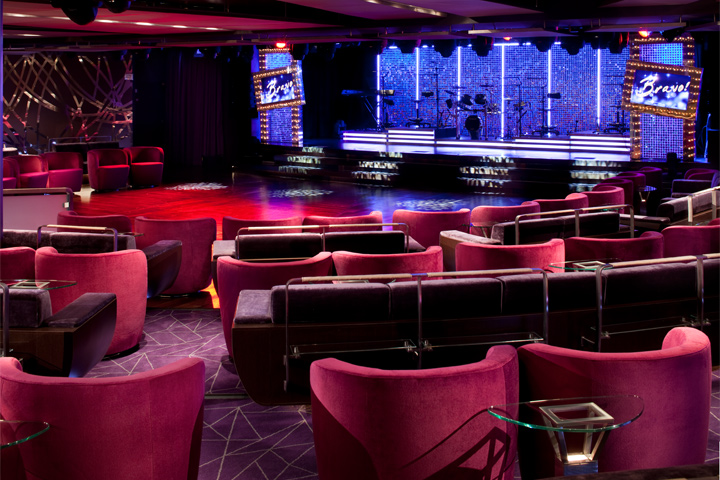
Show/Lounge
- Card Room
- Casino
- Disco/Nightclub
- Movies
- Movies Under the Stars®
- Theater/Show Lounge
- Fitness Center
- Fitness Classes
- Sauna/Steam Room
- Educational Programs
- Guest Lecturers
- Miniature Golf
- Pool - Outdoor
- Pool - Indoor/Covered
- Water Sports Platform
- Whirlpool/Jacuzzi
- Art Gallery
- Bars/Lounges
- Internet Center
- Library
- Business Center
- Concierge Desk
- Conference Center
- Duty-Free Shops/Boutiques
- Elevators
- Infirmary/Medical Center
- Religious Services
- Safe Deposit Boxes
- Self-Service Laundromat
- Wedding/Vow Renewal
Activities & Services (available for an extra fee)
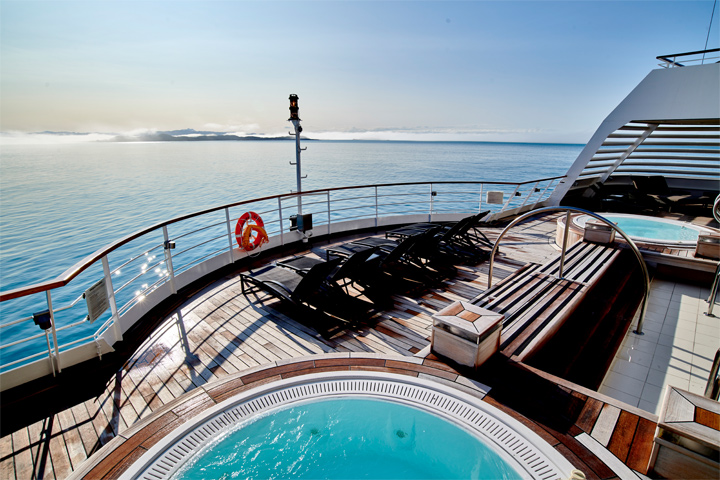
Spa
- Beauty Salon
- Full-Service Spa
- Spa Services/Massage
- Rock-Climbing Wall
- Scuba Diving PADI
- Sports Facilities
- Surfing
- Water Park Arena
- Water Slide
- Dry Cleaning/ Laundry Service
Main Dining
The Restaurant: Come when you like, with whom you please, and be seated as you wish. The room is beautiful, the cuisine is exquisite, and the service is simultaneously flawless, friendly and fun.
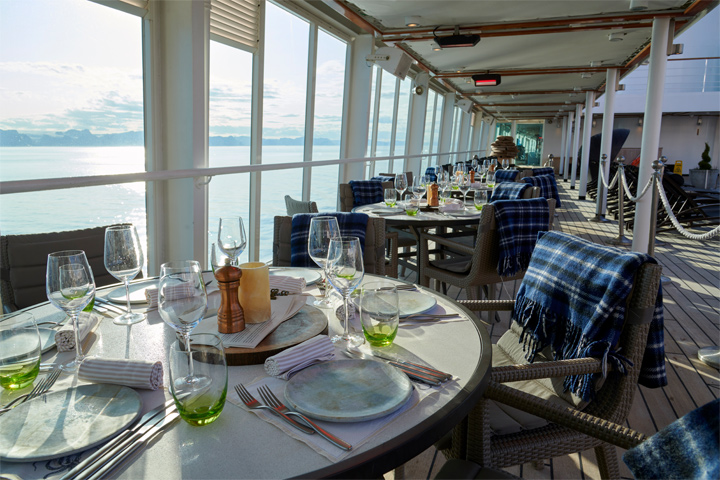
The Colonnade
Casual Dining
Coffee Bar: Enjoy a specialty crafted espresso just the way you like it.
Earth & Ocean: Each evening, the skilled chefs create an imaginative array of fresh, inventive dishes—a sophisticated menu celebrating eclectic traditional flavors from around the world, served in a relaxed setting under the stars for a distinctive dining experience unlike any other on board.
Observation Bar: A stunning round lounge with a square bar and panoramic views. Early Risers’ Coffee and Tea is served here every morning, and piano music makes it a great choice for drinks and conversation before and after dinner.
Seabourn Square: Whether you're looking for a place to enjoy your newspaper in the morning or want to socialize with your fellow passengers, Seabourn Square is what you're looking for. This inviting lounge offers plush seating, cocktail tables, a library, computer terminals, a coffee bar, and Guest Services staff.
Solis: Offering light, modern Mediterranean cuisine bursting with color and character, prepared fresh and entirely from scratch.
The Club: Open for afternoon tea then transforms into a dance club in the evening. Socialize while enjoying cocktails, live music, and great company. Serving a variety of light sushi bites freshly made to order each evening.
The Colonnade: The more casual, indoor/outdoor alternative features an open kitchen, lavish buffets or table service for breakfasts and lunch, and serves regionally themed, bistro-style dinners with table service nightly.
The Patio: Relaxed poolside dining offering luncheon buffets, salads, soups, grilled specialties and freshly baked pizza. Dinners feature a full menu in an alfresco setting.
Sky Bar: A place to enjoy a refreshing tropical beverage during the day, or an evening cocktail under the stars.
In-Suite Dining: A varied menu available around the clock for service in your suite. You may also order dinner from The Restaurant menu and have your meal served, course by course, in your suite or on your veranda.
All Ocean View Suites feature a large picture window, comfortable living area, queen-size bed or two twin beds, dining table for two, walk-in closet, interactive flat-screen television with music and movies, fully stocked bar and refrigerator, makeup vanity, spacious bathroom with separate tub and shower. Approximately 295 sq. ft. (28 sq.m.) of inside space.
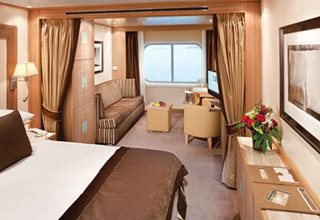
Category: A1
All Ocean View Suites feature a large picture window, comfortable living area, queen-size bed or two twin beds, dining table for two, walk-in closet, interactive flat-screen television with music and movies, fully stocked bar and refrigerator, makeup vanity, spacious bathroom with separate tub and shower.
Approximately 295 sq. ft. (28 sq.m.) of inside space.

Category: A
All Ocean View Suites feature a large picture window, comfortable living area, queen-size bed or two twin beds, dining table for two, walk-in closet, interactive flat-screen television with music and movies, fully stocked bar and refrigerator, makeup vanity, spacious bathroom with separate tub and shower.
Approximately 295 sq. ft. (28 sq.m.) of inside space.

Category: RR
This category can be booked for a special rate, guaranteed to you. Please note that the category is not associated at the time of booking with a specific stateroom, deck, bedding configuration or other particular settings. The assignment of an actual cabin will be performed during your check-in. The cabin can be anywhere on the ship.

Category: OS
This category can be booked for a special rate, guaranteed to you. Please note that the category is not associated at the time of booking with a specific stateroom, deck, bedding configuration or other particular settings. The assignment of an actual cabin will be performed during your check-in. The cabin can be anywhere on the ship.
All Veranda Suites feature a full-length window and glass door to private veranda, comfortable living area, queen-size bed or two twin beds, dining table for two, walk-in closet, interactive flat-screen television with music and movies, fully stocked bar and refrigerator, makeup vanity, spacious bathroom with separate tub and shower.
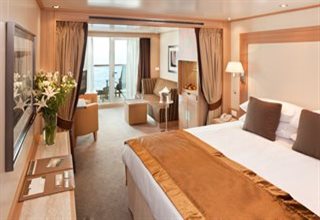
Category: V4
All Veranda Suites feature a full-length window and glass door to private veranda, comfortable living area, queen-size bed or two twin beds, dining table for two, walk-in closet, interactive flat-screen television with music and movies, fully stocked bar and refrigerator, makeup vanity, spacious bathroom with separate tub and shower.

Category: V3
All Veranda Suites feature a full-length window and glass door to private veranda, comfortable living area, queen-size bed or two twin beds, dining table for two, walk-in closet, interactive flat-screen television with music and movies, fully stocked bar and refrigerator, makeup vanity, spacious bathroom with separate tub and shower.

Category: V2
All Veranda Suites feature a full-length window and glass door to private veranda, comfortable living area, queen-size bed or two twin beds, dining table for two, walk-in closet, interactive flat-screen television with music and movies, fully stocked bar and refrigerator, makeup vanity, spacious bathroom with separate tub and shower.

Category: V1
All Veranda Suites feature a full-length window and glass door to private veranda, comfortable living area, queen-size bed or two twin beds, dining table for two, walk-in closet, interactive flat-screen television with music and movies, fully stocked bar and refrigerator, makeup vanity, spacious bathroom with separate tub and shower.

Category: SV
This category can be booked for a special rate, guaranteed to you. Please note that the category is not associated at the time of booking with a specific stateroom, deck, bedding configuration or other particular settings. The assignment of an actual cabin will be performed during your check-in. The cabin can be anywhere on the ship.

Category: RB
This category can be booked for a special rate, guaranteed to you. Please note that the category is not associated at the time of booking with a specific stateroom, deck, bedding configuration or other particular settings. The assignment of an actual cabin will be performed during your check-in. The cabin can be anywhere on the ship.
All Penthouse Suites on board feature a comfortable living area, glass door to private veranda, queen-size bed or two twin beds; walk-in closet with personal safe, two flat-screen TV with music and movies, fully stocked bar and refrigerator, writing desk with personalized stationary, makeup vanity, spacious bathroom with separate tub and shower, plush robes, slippers hair dryer and 110/220V AC outlets.
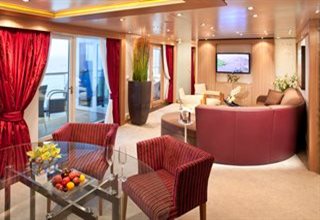
Category: GR
Suites on board feature a comfortable living area, private veranda, queen-size-bed or two twin beds; walk-in closet with personal safe, interactive flat-screen TV with music and movies, fully stocked bar and refrigerator, writing desk with personalized stationary, makeup vanity, spacious bathroom with separate tub and shower, plush robes, slippers, hair dryer, and 110/220V AC outlets.

Category: WG
Suites on board feature a comfortable living area, private veranda, queen-size-bed or two twin beds; walk-in closet with personal safe, interactive flat-screen TV with music and movies, fully stocked bar and refrigerator, writing desk with personalized stationary, makeup vanity, spacious bathroom with separate tub and shower, plush robes, slippers, hair dryer, and 110/220V AC outlets.

Category: SS
Suites on board feature a comfortable living area, private veranda, queen-size-bed or two twin beds; walk-in closet with personal safe, interactive flat-screen TV with music and movies, fully stocked bar and refrigerator, writing desk with personalized stationary, makeup vanity, spacious bathroom with separate tub and shower, plush robes, slippers, hair dryer, and 110/220V AC outlets.
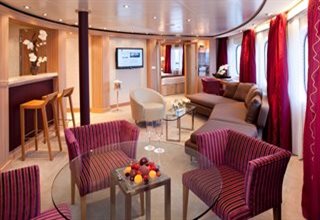
Category: O2
Suites on board feature a comfortable living area, private veranda, queen-size-bed or two twin beds; walk-in closet with personal safe, interactive flat-screen TV with music and movies, fully stocked bar and refrigerator, writing desk with personalized stationary, makeup vanity, spacious bathroom with separate tub and shower, plush robes, slippers, hair dryer, and 110/220V AC outlets.

Category: O1
Suites on board feature a comfortable living area, private veranda, queen-size-bed or two twin beds; walk-in closet with personal safe, interactive flat-screen TV with music and movies, fully stocked bar and refrigerator, writing desk with personalized stationary, makeup vanity, spacious bathroom with separate tub and shower, plush robes, slippers, hair dryer, and 110/220V AC outlets.
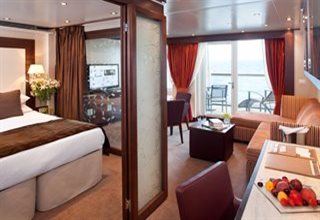
Category: PS
All Penthouse Suites on board feature a comfortable living area, glass door to private veranda, queen-size-bed or two twin beds; walk-in closet with personal safe, two flat-screen TV with music and movies, fully stocked bar and refrigerator, writing desk with personalized stationary, makeup vanity, spacious bathroom with separate tub and shower, plush robes, slippers, hair dryer, and 110/220V AC outlets.

Category: PH
All Penthouse Suites on board feature a comfortable living area, glass door to private veranda, queen-size-bed or two twin beds; walk-in closet with personal safe, two flat-screen TV with music and movies, fully stocked bar and refrigerator, writing desk with personalized stationary, makeup vanity, spacious bathroom with separate tub and shower, plush robes, slippers, hair dryer, and 110/220V AC outlets.

Category: PG
This category can be booked for a special rate, guaranteed to you. Please note that the category is not associated at the time of booking with a specific stateroom, deck, bedding configuration or other particular settings. The assignment of an actual cabin will be performed during your check-in. The cabin can be anywhere on the ship.
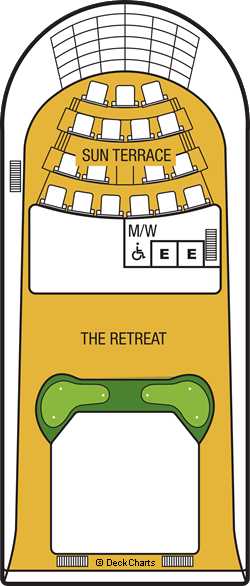
| Symbol | Description |
|---|---|
 | Suite can be reached only via a staircase |
 | Elevator |
 | Wheelchair-accessible suite; roll-in shower only; wheelchair-accessible doorways; Suite 635 also has a tub |
 | Self service launderette |
 | Partially obstructed veranda view |
 | Smaller veranda |
 | Veranda railings are part metal and part glass from floor to teak rail |
 | Subject to noise when anchoring; has all-metal veranda railings, limiting the view |
 | Third guest capacity suite |
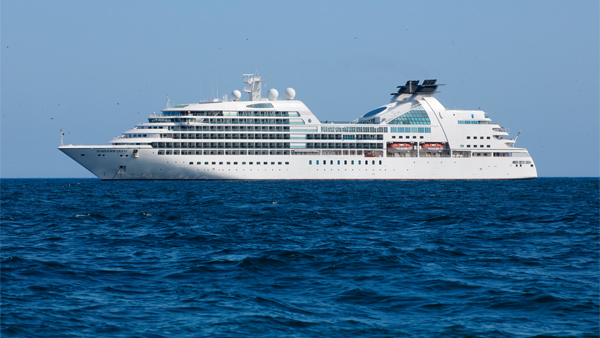
- Ship Name: Seabourn Quest
- Year Built: 2010
- Year Entered Present Fleet: 2011
- Ship Class: O
- Maximum Capacity: 458
- Number of Passenger Decks: 9
- Number of Crew: 295
- Officers' Nationality: International
- Tonnage (GRT): 32,000
- Capacity Based on Double Occupancy: 458
- Country of Registry: The Bahamas
- Total Staterooms: 229
- Crew/Hotel Staff Nationality: International
Costco Member Reviews

Available Dates & Prices
Terms & Conditions
*Price shown is per person based on double occupancy, is valid for select stateroom categories only, and does include government taxes/fees and gratuities. Click on the Terms & Conditions link below for details.
**Select complimentary shore excursions are for full-fare guests only, capacity controlled and subject to availability. Shore excursion reservations are accepted on a first-come, first-served basis. Please note, available excursions vary by sailing date and day of the week. Government fees and taxes are included. Requested excursions may not be available at time of booking. Supplement will apply on Ventures by Seabourn®, optional shore excursions. Restrictions apply and penalties apply 36 hours prior to shore excursion start date.
†One Digital Costco Shop Card per room/stateroom, per stay. The exact amount of the Digital Costco Shop Card will be calculated during the booking process. The Digital Costco Shop Card promotion is nontransferable and may not be combined with any other promotion. A Digital Costco Shop Card will arrive by email approximately 10 days after the start of your cruise. Click on the Terms & Conditions link below for additional information.
Ship's registry: The Bahamas
Digital Costco Shop Card
This booking includes a Digital Costco Shop Card which will arrive by email one to two weeks after you return from your vacation. The Digital Costco Shop Card is a convenient payment option in our warehouses and on Costco.ca.

























